|
Search, browse, and study this dictionary to learn more about the early American, Christian language. 
 1828.mshaffer.com › Word [pale]
1828.mshaffer.com › Word [pale]
PALE, a. [L. palleo,pallidus.] 1. White or whitish; wan; deficient in color; not ruddy or fresh of color; as a pale face or skin; pale cheeks. We say also, a pale red, a pale blue,that is, a whitish red or blue. Pale is not precisely synonymous with white, as it usually denotes what we call wan, a darkish dun white.2. Not bright; not shining; of a faint luster; dim; as the pale light of the moon. The night, methinks, is but the daylight sick; It looks a little paler.PALE, v.t. To make pale. PALE, n. [L. palus; coinciding with Eng. pole, as well as pale. It has the elements of L. pala,a spade or shovel.] 1. A narrow board pointed or sharpened at one end, used in fencing or inclosing. This is with us more generally called a picket.2. A pointed stake; hence to empale,which see.3. An inclosure; properly,that which incloses, like fence, limit; hence,the space inclosed. He was born within the pale of the church; within the pale of christianity.4. District; limited territory.5. In heraldry, an ordinary, consisting of two perpendicular lines drawn from the top to the base of the escutcheon, and containing the third middle part of the field.PALE, v.t. To inclose with pales or stakes. 1. To inclose; to encompass.
|
Evolution (or devolution) of this word [pale]
| 1828 Webster | 1844 Webster | 1913 Webster |
|---|
PALE, a. [L. palleo,pallidus.] 1. White or whitish; wan; deficient in color; not ruddy or fresh of color; as a pale face or skin; pale cheeks. We say also, a pale red, a pale blue,that is, a whitish red or blue. Pale is not precisely synonymous with white, as it usually denotes what we call wan, a darkish dun white.2. Not bright; not shining; of a faint luster; dim; as the pale light of the moon. The night, methinks, is but the daylight sick; It looks a little paler.PALE, v.t. To make pale. PALE, n. [L. palus; coinciding with Eng. pole, as well as pale. It has the elements of L. pala,a spade or shovel.] 1. A narrow board pointed or sharpened at one end, used in fencing or inclosing. This is with us more generally called a picket.2. A pointed stake; hence to empale,which see.3. An inclosure; properly,that which incloses, like fence, limit; hence,the space inclosed. He was born within the pale of the church; within the pale of christianity.4. District; limited territory.5. In heraldry, an ordinary, consisting of two perpendicular lines drawn from the top to the base of the escutcheon, and containing the third middle part of the field.PALE, v.t. To inclose with pales or stakes. 1. To inclose; to encompass. |
PALE, a. [Fr. pale, palir; L. palleo, pallidus; Russ. bielie, white; bieliju, to whiten. It is probably allied to Sax. falewe, fealo, fallow, pale red or yellow, D. vaal, from the sense of failing, withering; W. pallu, to fail. See Class Bl, No. 6, 7, 13, 18.]- White or whitish; wan; deficient in color; not ruddy or fresh of color; as, a pale face or skin; pale cheeks. We say also, a pale red, a pale blue, that is, a whitish red or blue. Pale is not precisely synonymous with white, as it usually denotes what we call wan, a darkish dun white.
- Not bright; not shining; of a faint luster; dim; as, the pale light of the moon.
The night, methinks, is but the daylight sick; / It looks a little paler. – Shak.
PALE, n. [Sax. pal; G. pfahl; G. paal; Sw. påle; Dan. pæl; W. pawl; L. palus; coinciding with Eng. pole, as well as pale; Russ. palitz, a stick or club. It has the elements of L. pala, a spade or shovel, and the radical sense is probably an extended thing, or a shoot. Qu. Ar. نَبَلَ nabala, to dart. Class Bl. No. 18.]- A narrow board pointed or sharpened at one end, used in fencing or inclosing. This is with us more generally called a picket.
- A pointed stake; hence to empale, – which see.
- An inclosure; properly, that which incloses, like fence, limit; hence the space inclosed. He was born within the pale of the church; within the pale of Christianity. – Atterbury.
- District; limited territory. – Clarendon.
- In heraldry, [one of the greater ordinaries, being a broad perpendicular line. – E.H.B.]
PALE, v.t.1To make pale. – Shak. Prior.
PALE, v.t.2 [D. paalen; G. pfählen.]- To inclose with pales or stakes. – Mortimer.
- To inclose; to encompass. – Shak.
|
Pale
- Wanting in color; not ruddy; dusky white;
pallid; wan; as, a pale face; a pale red; a pale
blue.
- Paleness; pallor.
- To turn pale] to lose color or luster.
- To make pale; to
diminish the brightness of.
- A pointed stake or slat,
either driven into the ground, or fastened to a rail at the top and
bottom, for fencing or inclosing; a picket.
- To inclose with pales,
or as with pales; to encircle; to encompass; to fence off.
- Not bright or brilliant; of a faint luster
or hue; dim; as, the pale light of the moon.
- That which incloses or fences in; a
boundary; a limit; a fence; a palisade.
- A space or field having bounds or limits; a
limited region or place; an inclosure; -- often used
figuratively.
- A stripe or band, as on a garment.
- One of the greater
ordinaries, being a broad perpendicular stripe in an escutcheon,
equally distant from the two edges, and occupying one third of
it.
- A cheese scoop.
- A shore for bracing a
timber before it is fastened.
|
| 1828 Webster | 1844 Webster | 1913 Webster |
|---|
Thank you for visiting!
- Our goal is to try and improve the quality of the digital form of this dictionary being historically true and accurate to the first American dictionary. Read more ...
- Below you will find three sketches from a talented artist and friend depicting Noah Webster at work. Please tell us what you think.
Divine Study
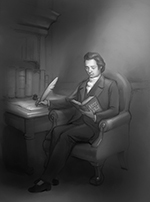 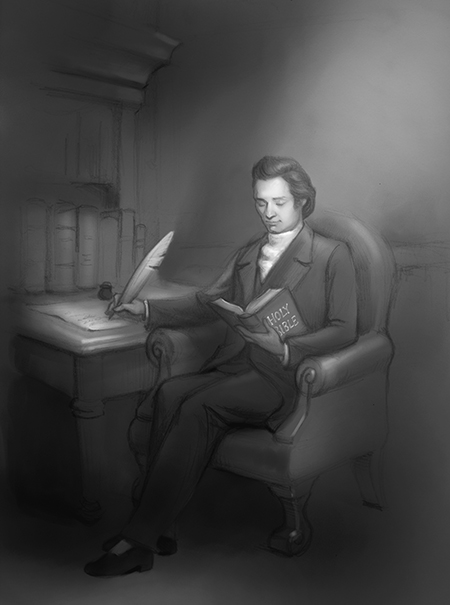
Divine Study
|
Window of Reflection
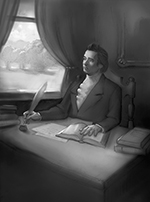 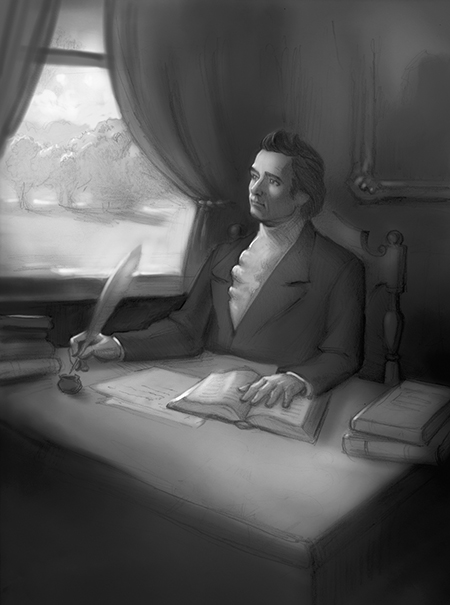
Window of Reflection
|
Enlightening Grace
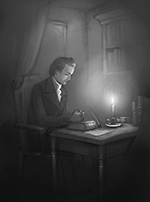 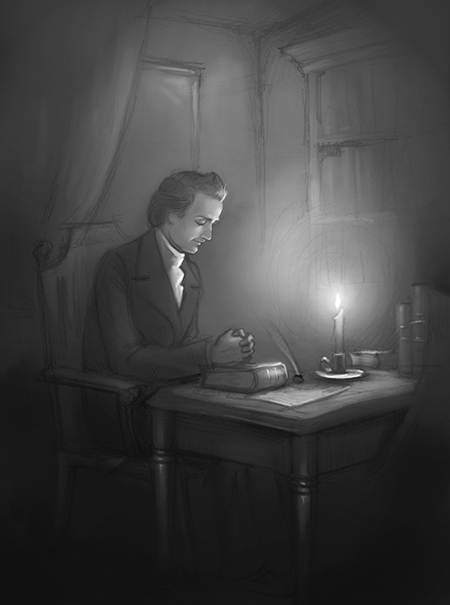
Enlightening Grace
|
159
|
932 |
111
|
1018 |
186
|
1046 |

Pale PALE, adjective [Latin palleo, pallidus.] 1. White or whitish; wan; deficient in color; not ruddy or fresh of color; as a pale face or skin; pale cheeks. We say also, a pale red, a pale blue, that is, a whitish red or blue. pale is not precisely synonymous with white, as it usually denotes what we call wan, a darkish dun white. 2. Not bright; not shining; of a faint luster; dim; as the pale light of the moon. The night, methinks, is but the daylight sick; It looks a little paler. PALE, verb transitive To make pale PALE, noun [Latin palus; coinciding with Eng. pole, as well as pale It has the elements of Latin pala, a spade or shovel.] 1. A narrow board pointed or sharpened at one end, used in fencing or inclosing. This is with us more generally called a picket. 2. A pointed stake; hence to empale, which see. 3. An inclosure; properly, that which incloses, like fence, limit; hence, the space inclosed. He was born within the pale of the church; within the pale of christianity. 4. District; limited territory. 5. In heraldry, an ordinary, consisting of two perpendicular lines drawn from the top to the base of the escutcheon, and containing the third middle part of the field. PALE, verb transitive To inclose with pales or stakes. 1. To inclose; to encompass. |

|
| Hard-cover Edition |
367 |
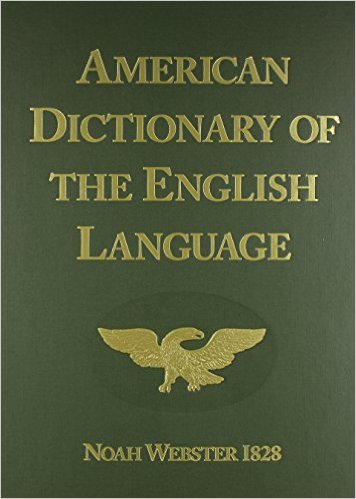 |
540 |
|
| Compact Edition |
353 |
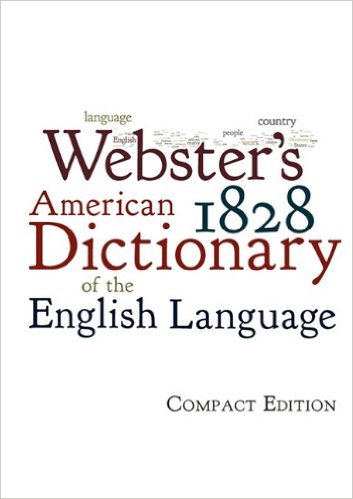 |
242 |
|
| CD-ROM |
303 |
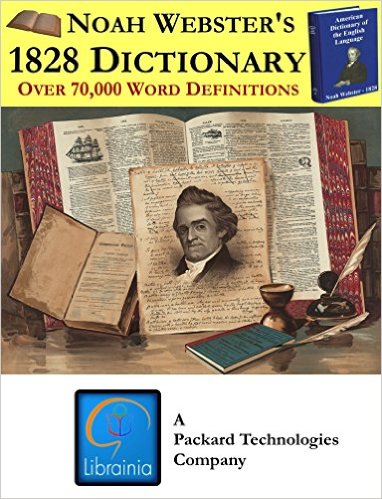 |
192 |
|
* As a note, I have purchased each of these products. In fact, as we have been developing the Project:: 1828 Reprint, I have purchased several of the bulky hard-cover dictionaries. My opinion is that the 2000-page hard-cover edition is the only good viable solution at this time. The compact edition was a bit disappointing and the CD-ROM as well. |
| [ + ] |
| Add Search To Your Site |
|
|
|
 1828.mshaffer.com › Word [pale]
1828.mshaffer.com › Word [pale]
